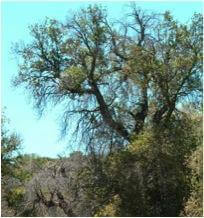
The soapberry borer (Agrilus prionurus) is native to Mexico. It was first detected in Texas in 2003, but it was probably present for several years before detection. Some reports of beetle damage are as early as 1998 (Billings and Pase 2009; Anonymous 2007). The currently known distribution is shown in the map above.
The only known host to the beetle is the Western Soapberry (Sapindus saponaria L. var. drummondii (Hook. & Arn.) L.D. Benson). Soapberry is a medium-sized, drought-hardy native tree that occurs in scattered patterns along creeks, and is occasionally used in native landscapes. (Merchant 2006; Billings and Pase 2009). Soapberry’s range extends from northern Mexico to Missouri, and west to Arizona (Billings and Pase 2009)
So far, the beetle’s attack kills all sizes of soapberry trees larger than 2 inches in diameter (Billings and Pase 2009).
The Texas Forest Service (TFS) has undertaken several initiatives to track the outbreak. In 2009, TFS sought input through a volunteer survey questionnaire sent to county extension agents and administrators of state parks and wildlife management areas, and posted on websites managed by the Texas invasive species council, Texas Forest Service, and International Society of Arborists Texas Chapter. TFS also tested the purple panel traps used by the emerald ash borer program, but found them not to be very effective (Billings and Pase 2009).
The Texas Forest Service has also begun studies on control methods. They are testing the efficacy of systemic pesticides (emamectin benzoate) injected into trees before infestation (Billings and Pase 2009). They are also doing emergence studies to determine the number of generations the beetle has per year – so far, the answer appears to be one (Billings and Pase 2009). In recent years, some predators and parasitoids have been detected in association with the soapberry borers (Billings, pers. comm. December 2014).
Soapberry borer spread has slowed in recent years, possibly as a result of the 2010 freeze and growing populations of natural enemies (Billings, pers. comm. December 2014).
USFS scientists and managers developed a conservation priority-setting framework for forest tree species at risk from pest & pathogens and other threats. The Project CAPTURE (Conservation Assessment and Prioritization of Forest Trees Under Risk of Extirpation) uses FIA data and expert opinion to group tree species under threat by non-native pests into vulnerability classes and specify appropriate management and conservation strategies. The scientists prioritized 419 tree species native to the North American continent. The analysis identified 15 taxonomic groups requiring the most immediate conservation intervention because of the tree species’ exposure to an extrinsic threat, their sensitivity to the threat, and their ability to adapt to it. Each of these 15 most vulnerable species, and several additional species, should be the focus of both a comprehensive gene conservation program and a genetic resistance screening and development effort. The soapberry borer is not known to be a threat to any of these 15 most vulnerable species.
For more information on this pest, please visit:
Sources
Anonymous. 2007. Past Chapter President, Jerry Pulley Credited with New US Record. In the Shade (Newsletter of ISA Texas Chapter, Vol. 30, No. 5 (March 2007)
Billings, R.F. personal communication, December 2014.
Billings, R. F. and H. A. Pase III, Texas Forest Service. No Date. Soapberry Borer, Agrilus prionurus (Coleoptera: Buprestidae) An Exotic Pest Recently Detected in Texas
Billings, R. F. and H. A. (Joe) Pase III, Texas Forest Service. 2009. Soapberry Borer Infestations Found in 33 Counties in Texas
Michael Merchant. 2006. TX A&M University fact sheet. Texas A&M University Research and Extension Center, Dallas;
Potter, K.M., Escanferla, M.E., Jetton, R.M., Man, G., Crane, B.S., Prioritizing the conservation needs of US tree spp: Evaluating vulnerability to forest insect and disease threats, Global Ecology and Conservation (2019), doi: https://doi.org/10.1016/



